SAP PMGM Module Training
SAP PMGM Provisioning
At SAP SuccessFactors and HCM, we delved deeply into Employee Central (EC), specifically examining how it integrates with core HR and payroll systems, as well as project types, category options, configuration strategies, and potential configuration issues that a front-end and back-end configuration may present.
SAP releases new systems through releases such as 1H and 2H. Certified SAP PMGM consultants must stay current with these updates by taking delta exams based on those releases.
SAP PMGM, you gain access to provisioning – the backend of SuccessFactors, where modules can be activated or deactivated for clients.
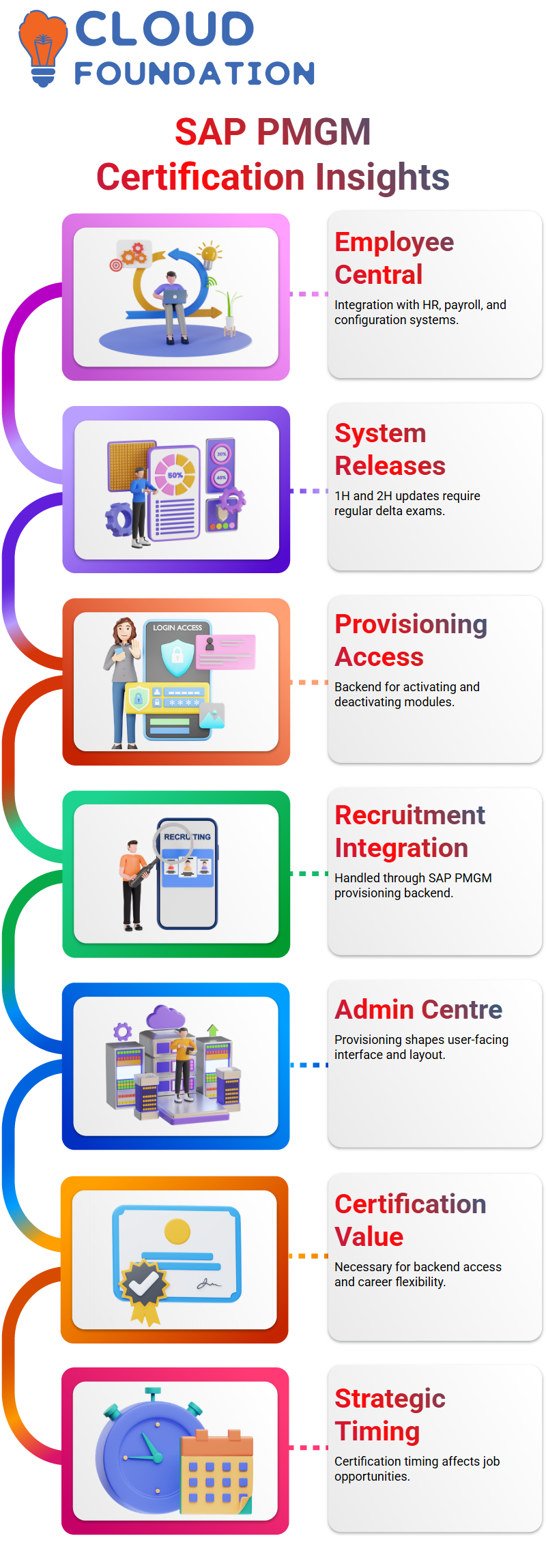
When an organisation decides to integrate recruitment software into its existing SAP PMGM setup, for example, provisioning is where this occurs. Without certification, it would not have been possible.
Provisioning in SAP PMGM extends far beyond simply acting as a control panel; it shapes what users see when accessing an instance, specifically the user-facing admin centre, as it determines its layout.
Once you complete the SAP PMGM certification, SAP provides you with a user ID and login credentials. Should you decide to switch jobs with different client requirements, however, your certification remains valid; update the provisioning access according to each new employer’s setup.
Determining when and why to pursue SAP PMGM certification can be challenging and should be approached strategically.
SAP PMGM Provisioning and Access Control
Provisioning is at the core of SAP PMGM configuration. Consultants use it to customise module settings, activate features, and make sure everything aligns with client needs – this backend environment can only be accessed with the SAP PMGM certification.
Provisioning enables users to turn modules on or off. If your client wishes to switch from SAP PMGM alone to a more comprehensive suite, activating certain features through provisioning is the answer; without it, SAP PMGM wouldn’t reflect these updates in real-life environments.
SAP PMGM consultants must also understand how instance access links into provisioning. Users interact daily with an instance (the admin centre), yet all settings they see were first configured via provisioning; thus, learning provisioning is essential, even if working only on frontend tasks.
Be mindful that different clients require varying provisioning setups, and that every implementation of SAP PMGM may vary; thus, requiring adaptability and continuous learning as you complete projects that deepen your knowledge about configuration and client-based customisation of SAP PMGM.
Being an SAP PMGM consultant means more than passing an exam: it means establishing credibility, access and visibility within the tech ecosystem. Your badge, provisioning abilities and understanding of SAP PMGM architecture position you as a specialist that companies can rely upon.
SAP PMGM provisioning should only be utilised by those with a valid SAP PMGM certification. Its power lies in being able to transform systems and workflows with extreme precision, so only those who have proven themselves through such certification are granted permission to utilise it.
SAP PMGM Instance vs Provisioning in Practice
SAP PMGM terminology might be unfamiliar to newcomers. When it is to ‘admin centre,’ it is our frontend instance, while provisioning serves as our backend system.
Each platform plays complementary roles: the admin centre is used for uploading user profiles and managing permissions, while provisioning handles backend system configuration and interface setup.
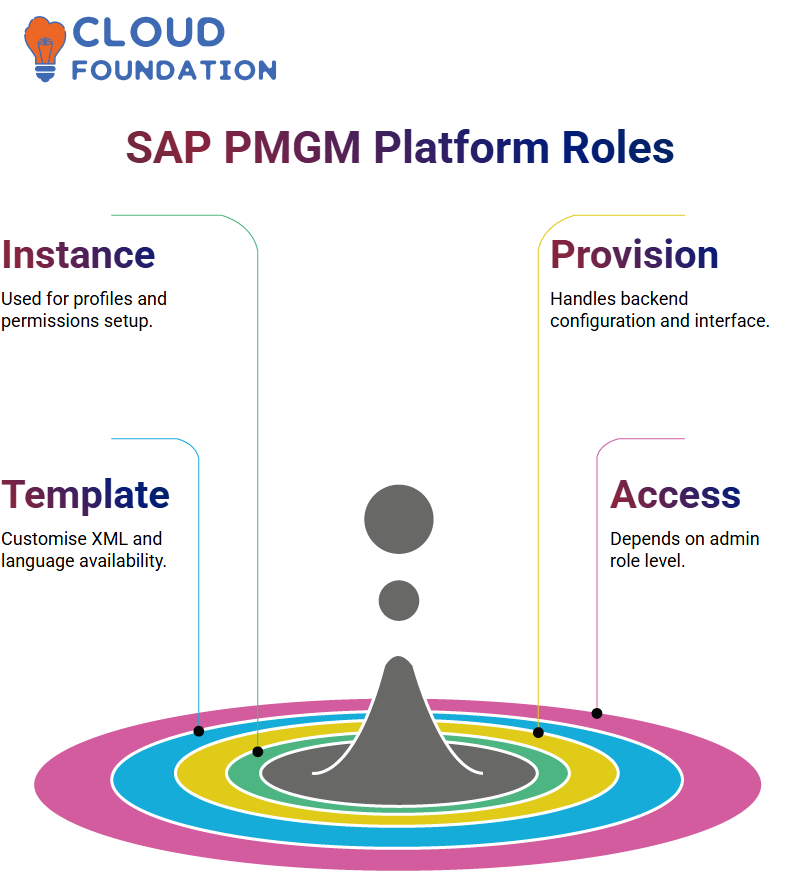
Provisioning powers module activations and global settings. While SAP PMGM’s provisioning setup may seem technical, its purpose is clear: here, you can customise XML templates, language availability, and activate SAP PMGM modules across your user base.
SAP PMGM Access
SAP PMGM access depends on your role; consultants typically handle this process, and the admin centre plays a crucial part. From local admin, global admin or super admin privileges, each role impacts SAP PMGM differently.
Support and implementation consultants often have administrative rights that allow them to modify configurations or view user profiles through proxy access.
SAP PMGM Admin Centre
SAP PMGM uses user roles to define access scopes. You’ll encounter admins, super admins, HR managers, and employees among them.
However, administrators and super admins tend to play an outsized role in making system adjustments, having rights to all profiles or settings, and even greater permissions granted to them as super admins.

Rika asked Rigi for instance access verification in SAP PMGM; Cloud Foundation will confirm access. Access allows you to replicate tasks and view configurations across users for an identical experience, which is vital if you want to follow along or test features live.
SAP PMGM Admin Tools
As an administrator in SAP PMGM, frequently access the Admin Centre. Here, schedule jobs, adjust upgrade settings, and configure performance templates not forgetting tools and reports, which fit precisely where expected. The layout is clean as everything resides perfectly where expected.
Knowledge Base Articles (KBAs) are go-to resources when they need assistance, whether it’s with calibration issues or goal plan configuration. SAP PMGM provides direct links to SAP help portals or community insights for further assistance.
SAP PMGM Module-Specific Tools and Integration
SAP PMGM integrates seamlessly with other modules, such as Calibration, Compensation, and Career Development Planning (CDP). From 360 Reviews to Succession Planning tools, these are organised within SAP PMGM by purpose for easy use.
SAP PMGM’s company-wide settings – from forms by user to goal import tools – remain consistent across modules, making the solution both scalable and flexible for organisations of various sizes.
XML and Data Model Configurations in SAP PMGM
SAP PMGM templates rely heavily on Extensible Markup Language (XML) as part of performance management and can download files via provisioning to facilitate work.
Any changes not within the goals may be edited offline before being uploaded again. Its flexible XML structure enables us to tailor fields specifically to business requirements.
Provisioning becomes imperative when making deeper modifications, as SAP PMGM success factor instances may restrict specific changes. However, with provisioning, global controls take precedence—a feature especially helpful when activating modules or changing language packs.
SAP PMGM and the MDF Framework
MDF (Managed Data Framework) plays an essential role in SAP PMGM’s Employee Central module. Admins use MDF to manage various backend settings and adjust user profiles effectively.
SAP PMGM permission logic can get very specific. Manage these through managed permission roles and groups.
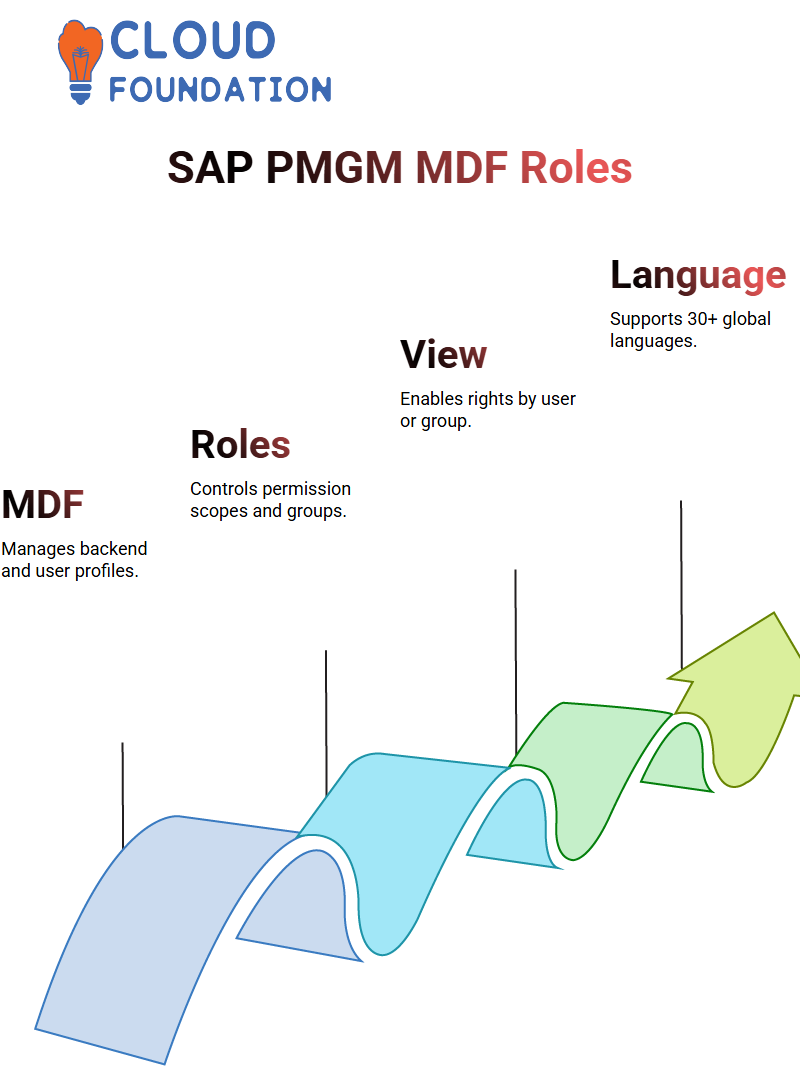
Generally speaking, provisioning applies globally across users; in contrast, instance view allows you to drill down further by setting rights individually or for groups such as HR departments.
Language Pack Activation in SAP PMGM
SAP PMGM supports more than 30 languages used across over 200 countries, including Chinese, Polish, French, Russian, and German, as well as various variants of English, such as UK and US English, and developer dialects. Teams can therefore view their interfaces in their native tongue to increase user adoption.
Once users enable languages from provisioning, they can switch their SAP PMGM screens to the language that best meets their preferences.
For instance, if your company has branches in Russia and China, employees there can easily switch their SAP PMGM experience to what best suits their language needs. You should instruct users during this setup step when they log in to the instance.
SAP PMGM Email Notification Templates and Triggers
SAP PMGM email notification templates enable you to notify users about document creations, updates and performance-related events as they occur. They’re customizable for optimal use once enabled – enable and go.

As soon as a performance document is created, users receive notifications with links to access it, which SAP PMGM facilitates through predefined template settings tied directly to each module.
Quick Actions and Rule Settings in SAP PMGM
SAP PMGM’s quick actions are invaluable tools. Instead of switching tabs for every need you may have, from reviewing forms to setting goals, click and go.
SAP PMGM integrates seamlessly with rule-based modules, such as RACM. Although its usage doesn’t rely heavily upon specific configurations, such as Employee Central, SAP PMGM still connects seamlessly when performance management overlaps with administrative duties.
SAP PMGM Interface
SAP PMGM provides quick access to features via search. For instance, searching for an employee’s name, such as “William,” quickly brings up their records.
SAP PMGM features an intuitive search bar that simplifies user actions, allowing users to easily access employee profiles, review approvals, and goal reviews, among other tasks.
Navigating To-Do Items and Notifications in SAP PMGM
One of the most helpful features in SAP PMGM is the to-do list. It appears on your left and displays tasks requiring your attention, like performance reviews or approval requests, as soon as something requires input on your behalf.
Notifications in SAP PMGM can be equally valuable, as they provide real-time alerts on requests, approvals, and feedback rejections. Furthermore, notifications can be customised so that the greeting and background image can be tailored specifically.
Navigating SAP PMGM Favourites and Recent Actions
SAP PMGM enables me to save time and streamline workflow when managing multiple reviews simultaneously by marking frequently used pages, such as form template settings, as favourites, thereby saving precious seconds.
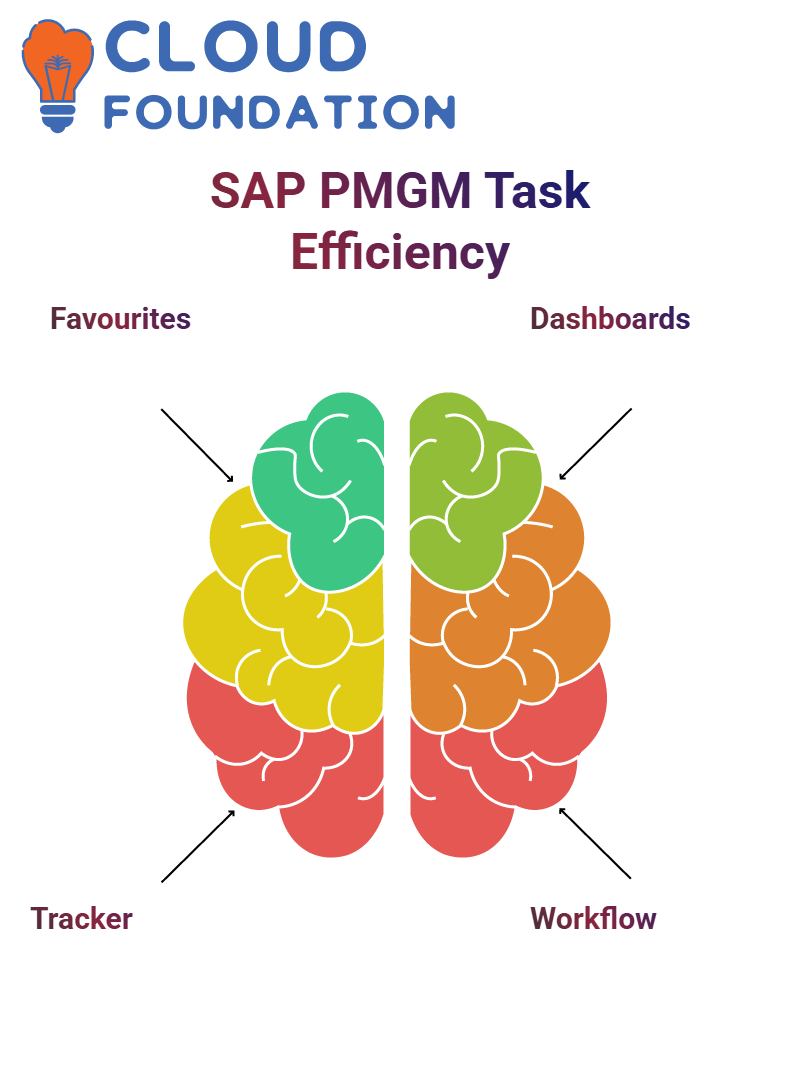 SAP PMGM makes everyday tasks more manageable with features like the Recent Action Tracker. All these small touches help SAP PMGM provide users with more peace of mind.
SAP PMGM makes everyday tasks more manageable with features like the Recent Action Tracker. All these small touches help SAP PMGM provide users with more peace of mind.
SAP PMGM Dashboards and Proxies
SAP PMGM dashboards provide a comprehensive view of everything — including due dates, review stages, and peer feedback — at a glance. When performance forms are in workflow, you can track their stages directly from your home page.
The proxy feature can also be an asset. As a super admin or consultant, acting on someone else’s behalf to test features can provide invaluable insight into how SAP PMGM behaves across roles without actually needing to log on as them themselves.
SAP PMGM Mobile Experience and Accessibility
SAP PMGM on mobile is just as useful as on a desktop. To get the app quickly and conveniently installed from an app store, search ‘SuccessFactors’ and sign in.

SAP PMGM still allows most core tasks such as authorising requests or monitoring performance goals to be performed from anywhere at any time, including mobile device support for advanced features like document approval.
SAP PMGM Modules: Exploring Performance and Onboarding
SAP PMGM encompasses multiple modules for employee management, including onboarding, P&P room features, and succession/career development. Together, these create a comprehensive ecosystem designed to monitor employee performance, growth, and feedback.
Although we may not use all the modules regularly, some are essential, including succession planning and reporting/analytics, which can provide invaluable assistance for tracking employee journeys. Additionally, permissioning and time management are also within the purview of SAP PMGM.
SAP PMGM: Compensation and Objectives
SAP PMGM demonstrated how compensation interacts with views and forms to facilitate performance evaluations and goal setting.
When discussing objectives about SAP PMGM, it is essential to understand that they represent similar concepts of measurable achievement.
SAP PMGM uses the term ‘objectives’ interchangeably when discussing goals; when this term appears, you’ll know it refers to the performance targets we set.
Objectives management has provided a crucial foundation for developing performance plans that align with business outcomes.
SAP PMGM and the 360 Degree Review Process
SAP PMGM The 360 Degree Review. Conducting one allows organisations to gather feedback from all areas of their organisations for an inclusive performance snapshot.
SAP PMGM includes this module, which enables the receipt of evaluations not only from managers but also from peers and clients, part of an initiative focused on continuous improvement through meaningful feedback loops.
Upgrading SAP PMGM Through the Admin Centre
Explore SAP PMGM’s administrative centre to access its upgrade centre for module enhancements. As SAP continues to evolve its platform, staying abreast of changes is part of a lifelong journey.
The standard procedure involves selecting the required module, reading its brief description, and activating any necessary updates.
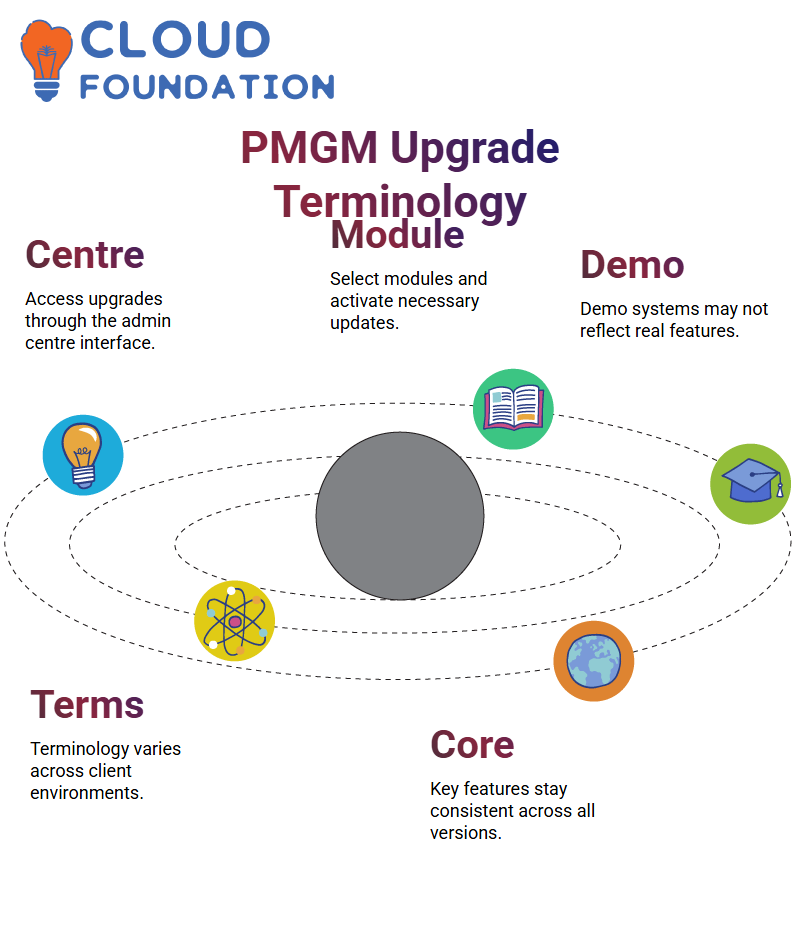 Although demo systems may not accurately reflect every change, real-life scenarios consistently provide robust features via SAP PMGM.
Although demo systems may not accurately reflect every change, real-life scenarios consistently provide robust features via SAP PMGM.
Variations in SAP PMGM Terminology Across Systems
SAP PMGM is versatile in terminology across client environments. What may be labelled ’employee export’ in one system may be called ‘colleague input’ in another.
Although the terminology varies slightly between versions of SAP PMGM, its core functionalities remain constant, allowing organisations to tailor their systems without jeopardising key capabilities.

SAP Course Price


Vinitha Indhukuri
Author

